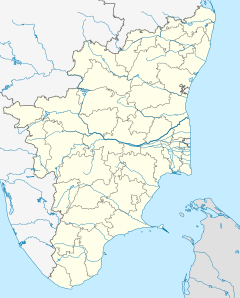Anekadhangavadeswarar Temple (also called Anegathangavadham) is a Hindu temple dedicated to Shiva, located in the town of Kanchipuram, near Kailasanathar temple, Kanchipuram district in Tamil Nadu, India. Anekadhangavadeswarar is revered in the 7th century Tamil Saiva canonical work, the Tevaram, written by Tamil saint poets known as the nayanars and classified as Paadal Petra Sthalam, the 275 temples revered in the canon.
| Anekadhangavadeswarar temple | |
|---|---|
 Anekadhangavadeswarar temple complex | |
| Religion | |
| Affiliation | Hinduism |
| District | Kanchipuram |
| Deity | Anekadhangavadeswarar(Shiva), Manonmani (Parvathi) |
| Location | |
| Location | Kanchipuram |
| State | Tamil Nadu |
| Country | India |
Location in Tamil Nadu | |
| Geographic coordinates | 12°50′31″N 79°41′28″E / 12.84194°N 79.69111°E |
| Architecture | |
| Type | Dravidian architecture |
The temple has two daily rituals at various times from 5:30 a.m. to 8 p.m., and three yearly festivals on its calendar, of which the Thirukarthikai during (November - December) and Mahashivarathri during February - March being the most prominent. The temple is maintained and administered by the Hindu Religious and Endowment Board of the Government of Tamil Nadu.
Etymology and legend
editAccording to legend, Vinayaka, the son of Shiva, established Anegabeswarar in the form a Lingam (an iconic representation of Shiva). Anegabeswarar is believed to have killed the demon Iraniyapura king Kesi and arranged for the marriage of his daughter Vallabai with Vinayaga. Kubera, the king of wealth is also believed to have worshipped Angebeswarar. There are two Anegathangavadham temples, one in the North and one in the South. This temple is referred as Kachi Angegathangavadham to differentiate it from the northern shrine.[1][2] The word Anekapa is believed to have been derived from elephant as it drinks water with its trunk and mouth. The elephant is believed have worshipped the king.[3]
Tirugnana Sambandar, a 7th-century Tamil Saivite poet, venerated Chandramouleeswarar in ten verses in Tevaram, compiled as the First Tirumurai. Sundarar, venerated Anegaveswarar in 10 verses in Tevaram, compiled as the Seventh Tirumurai. As the temple is revered in Tevaram, it is classified as Paadal Petra Sthalam, one of the 276 temples that find mention in the Saiva canon.[4] Sundarar mentions that Shiva prefers to reside at this most happening place.[5]
Architecture
editThe temple is located in Kanchipuram, on the way from the town to the Kanchi Kailasanathar Temple. Anekadhangavadeswarar temple complex has a single prakarams (outer courtyard) and a small rajagopuram (gateway tower) facing North. The central shrine faces east and holds the image of Anekadhangavadeswarar (Shiva) in the form of lingam made of granite.[1] As in other temples in Kanchipuram, there is no separate shrine of Parvathi as it is believed that Kamakshi of Kanchipuram is the common Parvathi shrine for all Shiva temples. The granite images of Nandi (the bull and vehicle of Shiva) is located axial to the sanctum. As in other Shiva temples of Tamil Nadu, the first precinct or the walls around the sanctum of Anekadhangavadeswarar has images of Dakshinamurthy (Shiva as the Teacher), Durga (warrior-goddess) and Chandikeswarar (a saint and devotee of Shiva). There is a separate shrine for Periya Vinayaga. The temple precinct is surrounded by granite walls.[4]
Worship and religious practises
editThe temple priests perform the puja (rituals) during festivals and on a daily basis. The temple rituals are performed two times a day; Kalasanthi at 8:00 a.m. and Sayarakshai at 6:00 p.m. Each ritual comprises four steps: abhisheka (sacred bath), alangaram (decoration), naivethanam (food offering) and deepa aradanai (waving of lamps) for both Anekadhangavadeswarar and Manonmani Amman. There are weekly rituals like somavaram (Monday) and sukravaram (Friday), fortnightly rituals like pradosham and monthly festivals like amavasai (new moon day), kiruthigai, pournami (full moon day) and sathurthi.[1][4] The Thirukarthikai during (November - December) and Maha Shivratri during February - March are the most prominent festivals celebrated in the temple.[4]
References
edit- ^ a b c C., Dr.Chandramouli (2003). Temples of Tamil Nadu - Kancheepuram district. Chennai: Directorate of Census Operations, Tamil Nadu.
- ^ Ayyar, P. V. Jagadisa (1991). South Indian shrines: illustrated. New Delhi: Asian Educational Services. ISBN 81-206-0151-3.
- ^ R., Dr. Vijayalakshmy (2001). An introduction to religion and Philosophy - Tévarám and Tivviyappirapantam (1st ed.). Chennai: International Institute of Tamil Studies. pp. 170–1.
- ^ a b c d "Sri Anekadhangavadeswarar temple". Dinamalar. Archived from the original on 9 November 2011. Retrieved 16 April 2011.
- ^ "Thirukachianegathangavadham". Thevaaram.Org. 2012. Retrieved 15 November 2015.
External links
edit- Media related to Anekadhangavadeswarar Temple at Wikimedia Commons
